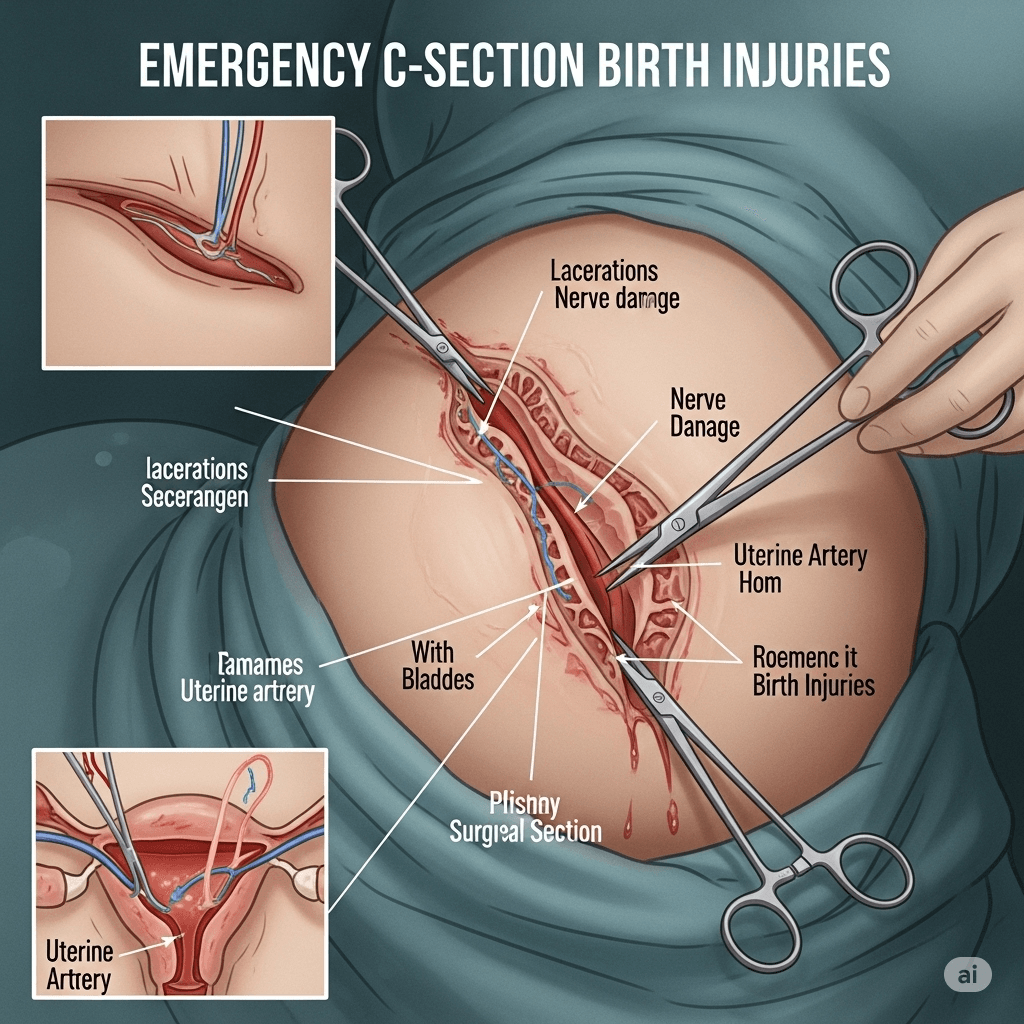While a Cesarean section (C-section) can be a life-saving intervention, especially in emergencies, the urgent nature of an Emergency C-Section Birth Injuries can sometimes result from inherent risks or medical negligence during the procedure. When immediate delivery is necessary to protect the mother or baby, rapid decision-making and execution are critical. However, errors or complications during an urgent C-section can have devastating consequences for the newborn. This article explores the risks associated with emergency C-sections and how they might contribute to preventable birth injuries.
The Urgency of Emergency C-Section Birth Injuries Can Highlight
An Emergency C-Section Birth Injuries can arise from is performed when there’s an immediate threat to the mother’s or baby’s life that necessitates rapid delivery. Such scenarios include severe fetal distress, umbilical cord prolapse, placental abruption, or uterine rupture. The speed required can increase the complexity of the surgery and, unfortunately, the potential for complications if not handled with utmost precision and care. While intended to prevent harm, sometimes urgent C-section procedures result in injuries linked to medical errors.
Common Complications Leading to Injuries from Emergency C-Sections
Even in urgent situations, medical professionals must adhere to the accepted standard of care. Deviations can result in birth injuries related to emergency C-sections:
1. Surgical Errors During Emergency C-Sections
- Lacerations/Incisions: Accidental nicks or cuts to the baby’s head, face, or body during the uterine incision. While minor nicks can occur without negligence, deep lacerations or those in critical areas (e.g., major blood vessels) can indicate Physician Negligence Birth Injury.
- Improper Force/Handling: Excessive pulling or twisting of the baby during delivery can lead to Spinal Cord Injuries Birth or nerve damage, even in a C-section setting.
2. Anesthesia Errors in Emergency C-Sections
- Maternal Complications: Improper administration of anesthesia can lead to maternal respiratory or cardiac arrest, causing oxygen deprivation to the baby and potentially a Brain Injury at Birth like Hypoxic-Ischemic Encephalopathy (HIE) Claims.
- Infant Distress: Too much anesthesia can also depress the baby’s breathing, a risk during an urgent C-section.
3. Delayed Performance of Emergency C-Section
- Failure to Act: While the C-section itself might be without surgical error, a negligent delay in deciding to perform the emergency delivery is a common cause of severe birth injuries. If signs of fetal distress (e.g., severe patterns on fetal monitoring strips) or maternal complications are ignored or responded to too slowly, critical oxygen deprivation can occur. This is a significant type of Preventable Medical Errors Birth can cause.
- Inadequate Preparation: Delays in assembling the surgical team or preparing the operating room can also lead to prolonged distress for the baby. This may also relate to Hospital Staffing Birth Injuries.
4. Post-Operative Negligence After Emergency C-Sections
- Inadequate Monitoring: Failure to properly monitor the newborn immediately after an urgent C-section, leading to undetected respiratory distress or other complications. This often falls under Nursing Negligence Birth Injury.
Seeking Legal Recourse for Emergency C-Section Birth Injuries
If your child suffered an injury from an emergency C-section, and you suspect medical negligence played a role (either in the surgery itself or in the delay leading to the emergency), pursuing a legal claim can provide necessary birth injury compensation. Your birth injury lawyer will investigate by:
- Meticulously reviewing Medical Records Birth Injury Claim documentation, including fetal monitoring strips, surgical notes, and anesthesia records.
- Consulting with Expert Witnesses Birth Injury Lawsuits require, such as obstetricians, neonatologists, and anesthesiologists, to determine if the standard of care was breached.
Understanding the statute of limitations for birth injury claims is vital for pursuing justice in cases involving complications from emergency C-sections.
If you want to call us and book a free call to discuss Emergency C-Section Birth Injuries and your legal options, contact here: Contact Trusted Birth Injury Lawyers | CPFamilyHelp
Frequently Asked Questions (FAQ) about Emergency C-Section Birth Injuries
Are all complications during an Emergency C-Section considered negligence?
No. Complications from an urgent C-section are not automatically negligent. The focus is on whether the medical professional acted below the accepted standard of care given the urgent circumstances.
What medical records are most important for lawsuits involving Emergency C-Section Birth Injuries?
Fetal monitoring strips, surgical notes, anesthesia records, and the time stamps of all decisions and actions are crucial Medical Records Birth Injury Claim elements. These help identify if preventable delays or errors occurred in an urgent C-section case.
Can a delay in performing an Emergency C-Section be considered negligence?
Yes, a significant and unjustified delay in performing an emergency C-section is often a key factor in birth injury claims, especially if it results in oxygen deprivation to the baby’s brain. This relates to Physician Negligence Birth Injury or Hospital Staffing Birth Injuries.
What kind of birth injuries are commonly associated with urgent C-sections?
Brain Injury at Birth (especially from oxygen deprivation due to delays), facial nerve palsies, skull fractures, and less commonly, internal organ injuries to the baby can be linked to complications arising from emergency C-sections.
How does Hospital Protocols Birth Injury Prevention relate to emergency C-sections?
Hospitals should have clear protocols for recognizing the need for and efficiently executing an emergency C-section. Deviations from these protocols can be strong evidence of negligence.




